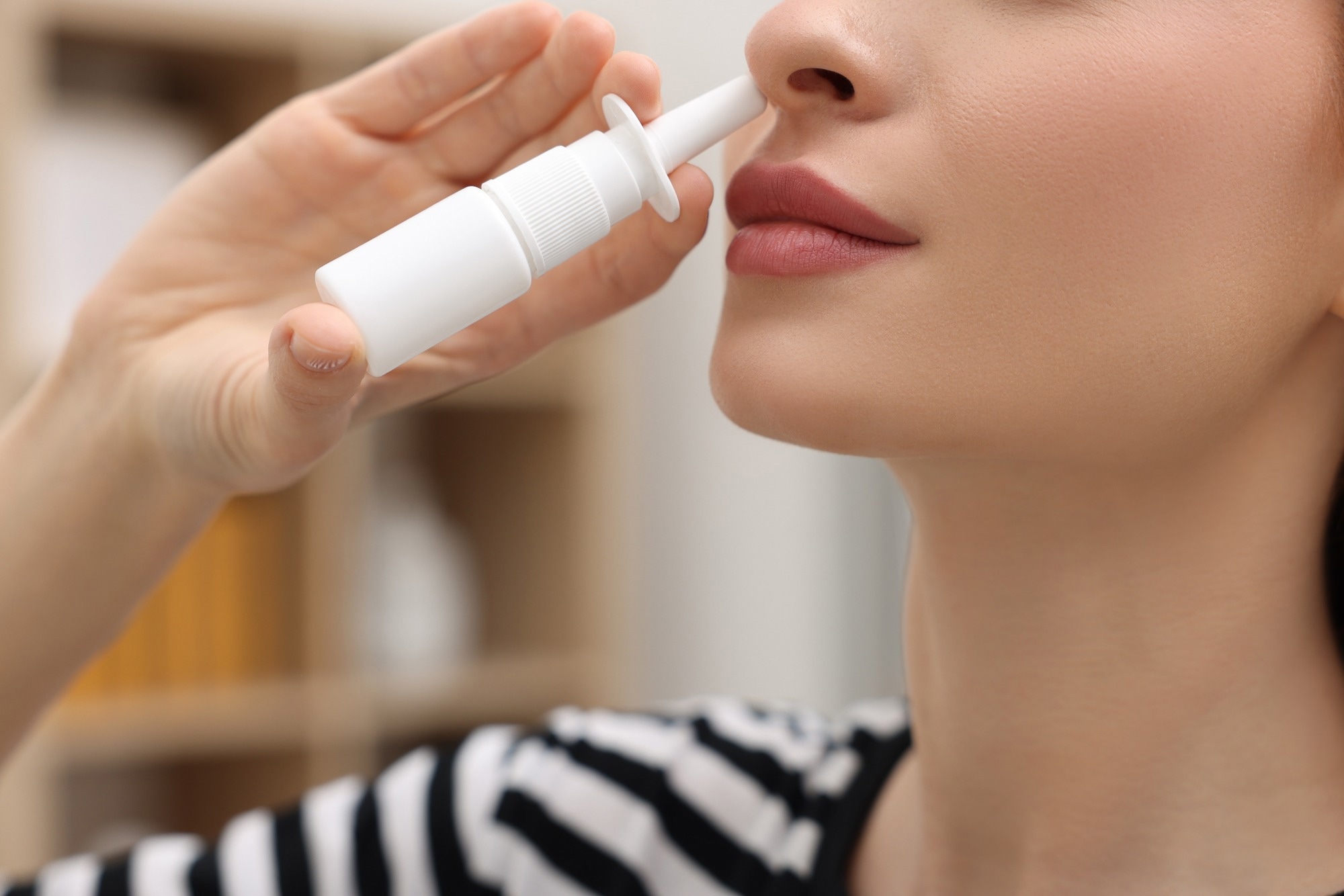A familiar allergy spray may do more than ease sneezing, researchers find azelastine could help block COVID-19 and other respiratory viruses, pointing to an accessible new line of defense.
 Study: Azelastine Nasal Spray for Prevention of SARS-CoV-2 Infections: A Phase 2 Randomized Clinical Trial. Image Credit: New Africa / Shutterstock.com
Study: Azelastine Nasal Spray for Prevention of SARS-CoV-2 Infections: A Phase 2 Randomized Clinical Trial. Image Credit: New Africa / Shutterstock.com
Variants of the severe acute respiratory syndrome coronavirus 2 (SARS-CoV-2), the virus responsible for the coronavirus disease 2019 (COVID-19) pandemic, continue to emerge almost six years after its initial emergence. A recent study published in JAMA Internal Medicine discusses the effects of azelastine nasal spray on the rate of SARS-CoV-2 infection as compared to placebo.
The antiviral effects of azelastine
Azelastine is a nasal antihistamine spray widely used to manage allergic rhinitis. Recent studies suggest that it exhibits antiviral activity in vitro against several respiratory viruses, including SARS-CoV-2; however, its clinical efficacy remains unclear.
These antiviral effects may arise following previously reported interactions between azelastine and the angiotensin converting enzyme 2 (ACE2) receptor, which is primarily used by SARS-CoV-2 to gain entry into cells. Other studies suggest that azelastine treatment inhibits the SARS-CoV-2 main protease (Mpro) enzyme, which mediates viral attachment to the host cell. Azelastine also appears to induce changes in the σ-1 receptor and inhibits intercellular adhesion molecule 1 (ICAM-1) expression.
Previous small randomized trials suggest that azelastine reduces the viral load in patients with SARS-CoV-2 infection, thus suggesting its potential effectiveness as a preventive. The present study explored the effectiveness and safety of azelastine nasal spray for reducing the incidence of SARS-CoV-2 infection.
About the study
The current study was a single-center, phase II randomized controlled trial comparing the use of azelastine nasal spray with placebo in 450 individuals. The mean age of the study participants was 33 years, most of whom were female and White.
Women of reproductive age were included only if they were neither pregnant nor breastfeeding and/or were using reliable contraception. A significant majority of study participants received one or more COVID-19 vaccinations, with the cohort receiving a median of three shots. In most cases, the most recent COVID-19 vaccine was administered two years before the current study began.
Study participants were randomly assigned to receive 0.1% azelastine or placebo nasal spray three times every day for a total of eight weeks. Notably, this dose of azelastine exceeds the twice daily use that is typically prescribed to manage moderate to severe allergic rhinitis.
Study participants were tested for SARS-CoV-2 infection by rapid antigen tests (RAT) twice weekly throughout the study period, and any positive test result was subsequently confirmed by polymerase chain reaction (PCR). Study participants who experienced respiratory symptoms but tested negative by RAT also underwent a PCR test for SARS-CoV-2 and other respiratory viruses.
Study findings
The azelastine group was less likely to be diagnosed with SARS-CoV-2 infection than controls at 2% and 6.7%, respectively. This observation indicates that azelastine reduces the risk of SARS-CoV-2 infection by about 70%.
Azelastine treatment also delayed the time to infection by 12 days as compared to the placebo group. Symptomatic COVID-19 infections were less likely in the azelastine group, with azelastine recipients remaining positive for SARS-CoV-2 for 1.7 days less than the control group, as assessed by self-reported RAT.
Even in times of higher exposure rates, fewer infections per exposure occurred under treatment compared with placebo.”
Aside from COVID-19, rhinovirus infections were the most common infection reported among study participants. Azelastine treatment was similarly found to reduce the risk of rhinovirus infections, with 2% of recipients infected as compared to 6% in the placebo group.
Overall, respiratory infections, as detected by PCR, affected 9% of the azelastine group as compared to 22% of controls. Participants who had antibodies indicating prior SARS-CoV-2 infection showed somewhat lower odds of testingpositive again, suggesting that baseline immune status modestly inflenced infection risk.
Importantly, adverse events were similar in overall frequency between groups but more commonly considered treatment-related in the azelastine group. However, most of these reactions were minor and well-known side effects like bitter taste, nosebleeds, and fatigue.
Conclusions
These findings support the potential of azelastine as a safe prophylactic approach warranting confirmation in larger, multicentric trials.”
The overall rate of new viral infections was low, thus indicating that azelastine may have broad antiviral activity. In particular, azelastine conferred protection against symptomatic rhinovirus infection, which may arise due to inhibition of the rhinovirus receptor ICAM-1. The authors noted that this is one of the first clinical trials to show reduced rhinovirus infection rates following a single therapy.
Azelastine is a safe, easily available, and convenient approach for pre-exposure prophylaxis of SARS-CoV-2 infection, which can be easily used in high-risk settings like public meetings or during travel. Nevertheless, the researchers cautioned that the study's single-center design, modest sample size, and potential unblinding due to azelastine's bitter taste limit generalizability. They also acknowledged that the placebo formulation itself could have had mild protective effects by stabilizing the nasal barrier.
The study was funded by Ursapharm Arzneimittel GmbH, the manufacturer of azelastine nasal spray, and conducted in collaboration with Saarland University researchers. Despite these promising findings, larger trials must be conducted to validate these observations and explore the potential utility of azelastine for other respiratory viruses.
Journal reference:
- Lehr, T., Meiser, P., Selzer, D., et al. (2025). Azelastine Nasal Spray for Prevention of SARS-CoV-2 Infections: A Phase 2 Randomized Clinical Trial. JAMA Internal Medicine. doi:10.1001/jamainternmed.2025.4283.